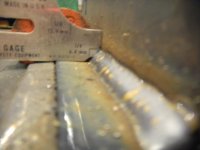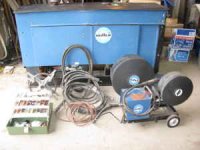thick? like 1/2" in single pass?
i'd like a good explanation of what that really means, other than someone read it off the manufacturer's literature.
the amount of weld applied to a particular joint has a minimal amount to do with the thickness of the material, aside from needing to be hot enough to to create proper fusion. the amount of weld required should be based on the load that the connection is required to take. many times the material thickness is driven by a bending consideration, or shear / tearout through a hole pattern. obviously, for most simple home shop weldments you don't know the exact load required, but you should know from observation that only in very specific cases do you need a weld that is capable of carrying the full tensile capacity of the material.
i've designed and drawn literally thousands of connections that use 1/2" material, and as a minimum they only require a 3/16" single pass fillet weld, unless the actual load on the connection dictates otherwise. aside from specific processes, such as submerged arc, a fillet weld is generally not allowed to be larger than 5/16" in a single pass, regardless of the size of the machine.
in actual practice, i built a skidding winch a couple years ago, and for the ears to connect to the 3ph lower arms i used 1/2" plate, because it was what i had around. i made them so they fit up with a slight gap between the ears and the channel frame, and used a small 120v wire feed welder to attach them. it was certainly pushing the limit of what it could do, but it did work fine. the very start of the weld was slightly cold, but once the arc heated the metal it went fine. very little welding actually requires 100% penetration. in my industry we try to redesign so we can avoid complete penetration, as it just adds a lot more work that isn't always necessary.


